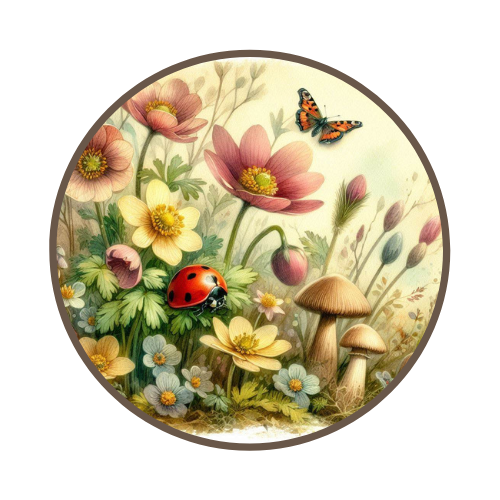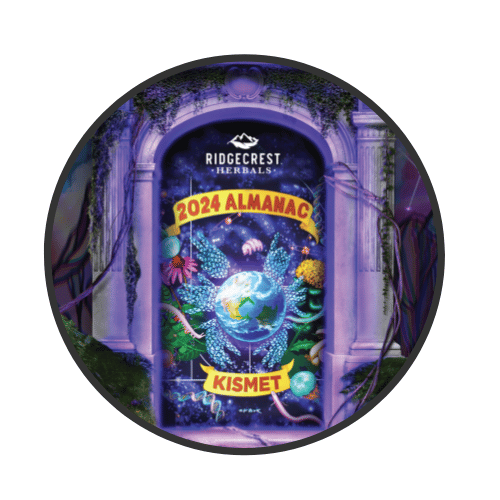Summer Garden Kismet: Embracing the Interconnected Magic of the Garden 🌿🦋🍄
Welcome to the vibrant heart of gardening season summer. This is when everything truly comes alive, from the soil beneath our feet to the pollinators dancing between blooms. As you step into your garden this season, it’s not just about flowers and veggies, it’s about witnessing a thriving ecosystem in motion.
In our 2024 Herbal Almanac, the theme is Kismet, the beautiful concept of fate and interconnectedness. It’s a perfect lens for viewing gardens, where every beetle, leaf, root, and raindrop plays a role in a larger, unseen choreography. Kismet reminds us that even the smallest interactions, like a ladybug devouring aphids or a mushroom sprouting after rain, are part of a greater plan that sustains life.
Whether you're a seasoned gardener or just planting your first tomato, this guide will help you appreciate the hidden harmony of summer gardens, and how you can support it with intention.
🐞 BUGS: Beneficial Insects Deserve a Home
Written by Birdy A.
When it comes to natural pest control, few allies are as iconic and effective as the ladybug. Often mistaken for pests in their larval stage, these beetles are actually your garden’s first line of defense against destructive insects like aphids, whiteflies, mites, and other scale bugs.
Life Cycle & How to Spot Them:
- Eggs: Bright orange clusters found on the underside of leaves.
- Larvae: Long black bodies with orange spots. (They might look scary, but they’re working for you!)
- Adults: The red-shelled friends we all recognize.
Each ladybug can consume up to 5,000 aphids in a lifetime. To attract more ladybugs and support their full life cycle:
How to Support Ladybugs in Summer:
- Avoid pesticides (even organic sprays can harm pollinators).
- Plant their favorites: yarrow, dill, fennel, calendula, marigold, and sweet alyssum.
- Leave natural shelter: Delay your garden cleanup until spring. Hollow stems and leaf piles provide winter hibernation spaces.
Ladybugs aren’t just cute, they’re part of the garden’s natural defense system. By making space for them, you’re promoting a more balanced and resilient garden environment.
🍄 FUNGI: Nature’s Silent Powerhouses
Written by Nichole P.
While flowers and fruit steal the show above ground, fungi are hard at work below the surface, breaking down organic matter, nourishing plants, and building microscopic highways of life.
Fascinating Fungi Facts for Summer:
- After spring rain, some fungi release spores in a phenomenon known as “mushroom rain.”
- Mycorrhizal fungi form partnerships with plant roots, helping plants absorb water and nutrients in exchange for sugars.
- The visible mushrooms are just the tip of the iceberg—the real magic happens underground in the mycelium network.
How to Encourage Fungi in Your Garden:
- Add organic matter: Use leaf litter, wood chips, and pine needles.
- Avoid tilling: It disrupts fungal networks and damages soil structure.
- Ditch synthetic fertilizers: They compact soil and can destroy fungal life.
- Apply compost, manure, and compost tea to feed your soil naturally.
Healthy fungal life leads to better nutrient cycling, improved water retention, and stronger, more disease-resistant plants. Want to dig deeper? Check out Mycelium Running by Paul Stamets or read “Mycelium in the Garden” by Shae (featured in our 2020 Almanac, free on our website!). Nichole also has a fantastic article on "5 Easy-to-Identify Mushrooms!"
🌳 PLANTS & TREES: Awakening to Summer’s Warmth
Written by Melissa C.
Summer is the season of growth and action. By now, plants are stretching toward the sun, leaves are in full photosynthesis mode, and roots are expanding deep into the earth.
But this growth depends on more than just sunlight, it’s tied to temperature, soil health, and plant genetics. Every species has a built-in rhythm, responding to daylight hours, warmth, and soil conditions to decide when and how to grow.
Smart Summer Gardening Tips:
- Mulch mindfully: Mulch retains moisture and insulates roots, but remove it only when nights are reliably above freezing.
- Prune wisely: Late winter or early spring is ideal. Avoid pruning during peak growth unless absolutely necessary.
- Watch the weather: A sudden frost or cold snap can shock young plants. Keep row covers or garden blankets nearby.
- Know your zone: Use your USDA Hardiness Zone to guide planting choices and frost protection plans.
- Be patient: Planting into cold or soggy soil can compact it and delay healthy root growth.
Your plants are guided by an invisible force, DNA, hormones, temperature, and light cues, that align with nature’s rhythm. When we tune in and support that rhythm, we become partners in a much bigger story.
🌱 Final Thought: Gardening With Intention
Summer gardens are more than food plots or flower beds, they're vibrant ecosystems, teeming with life. When we garden with awareness of kismet, of connection and fate, we see that no bug, spore, or leaf is random. Everything matters. And everything has a role.
From the ladybug battling aphids to the mycelium strengthening the soil beneath your feet, your garden is a living story of interdependence and balance.
Tend it with love. Observe with curiosity. And let the garden show you how much the natural world already knows.








Leave a comment
All comments are moderated before being published.
This site is protected by hCaptcha and the hCaptcha Privacy Policy and Terms of Service apply.